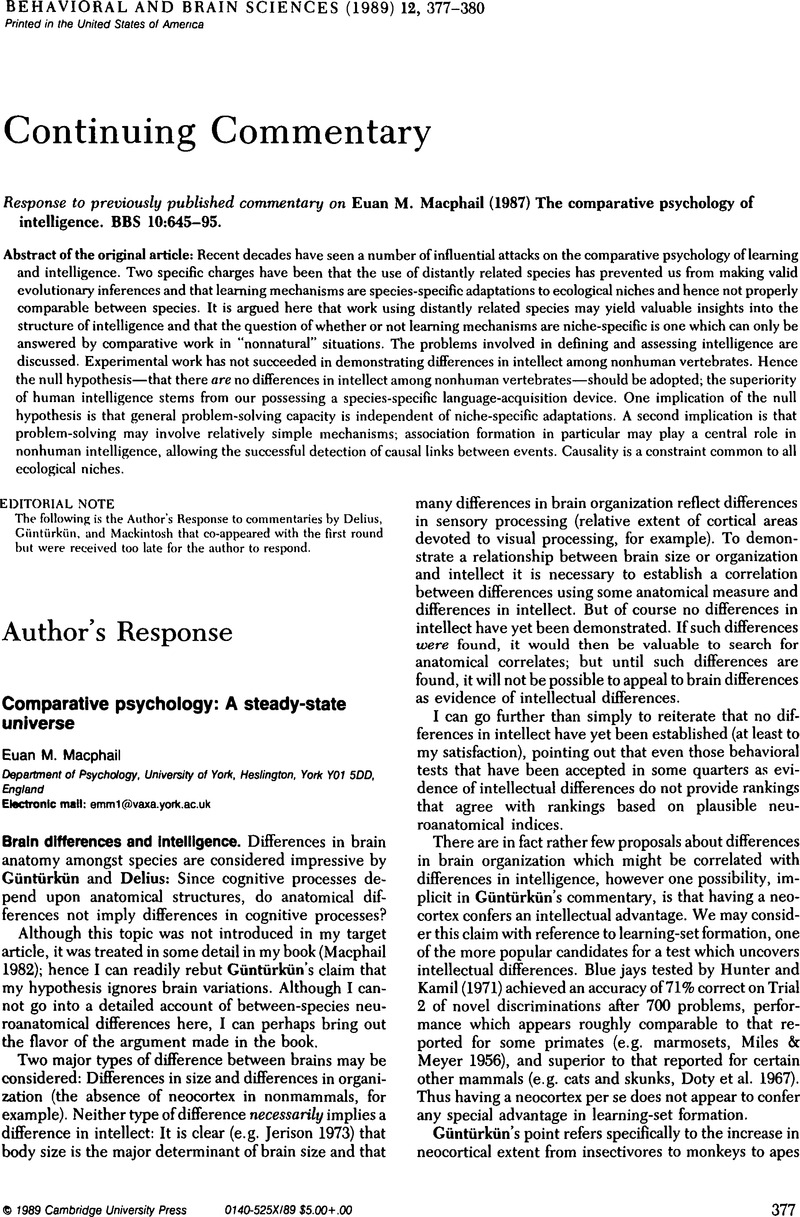No CrossRef data available.
Article contents
Comparative psychology: A steady-state universe
Published online by Cambridge University Press: 04 February 2010
Abstract
An abstract is not available for this content so a preview has been provided. Please use the Get access link above for information on how to access this content.

- Type
- Author's Response
- Information
- Copyright
- Copyright © Cambridge University Press 1989
References
Bitterman, M. E. (1969) Habit reversal and probability learning: Rats, birds and fish. In: Animal discrimination learning, ed. Gilbert, R. & Sutherland, N. S.. Academic PressGoogle Scholar
Bitterman, M. E. (1987) Evidence of divergence in vertebrate learning. Behavioral and Brain Sciences 10(4):659–60.CrossRefGoogle Scholar
Breuning, S. E. & Wolach, A. H. (1977) Successive negative contrast effects with goldfish (Carassius auratus). Psychological Record 27.565–75CrossRefGoogle Scholar
Breuning, S. E. & Wolach, A. H. (1979) Successive negative contrast effects for activity-conditioned goldfish (Carassius auratus) as a function of housing conditions. Psychological Record 29:245–54.CrossRefGoogle Scholar
Doty, B. A.Jones, C. N. & Doty, L. A. (1967) Learning-set formation by mink, ferrets, skunks, and cats. Science 155:1579–80.CrossRefGoogle Scholar
Engelhardt, F., Woodard, W. T. & Bitterman, M. E. (1973) Discrimination reversal in the goldfish as a function of training conditions. Journal of Comparative and Physiological Psychology 85:144–50.CrossRefGoogle Scholar
Hunter, M. W. & Kamil, A. C. (1971) Object-discrimination learning set and hypothesis behavior in the northern blue-jay (Cyanocitta cristata). Psychonomic Science 22:271–73.CrossRefGoogle Scholar
Mackintosh, N. J. (1969) Comparative studies of reversal and probability learning- Rats, birds, and fish. In: Animal discrimination learning, ed. Gilbert, R. & Sutherland, N. S.. Academic Press.Google Scholar
Mackintosh, N. J. (1971) Reward and aftereffects of reward in the learning of goldfish. Journal of Comparative and Physiological Psychology 76:225–32.CrossRefGoogle ScholarPubMed
Mackintosh, N. J. (1987) Neurobiology, psychology, and habituation. Behaviour Research and Therapy 25: 81–97.CrossRefGoogle ScholarPubMed
Macphail, E. M.(1987) Comparing intelligences Not easy, but not impossible. Behavioral and Brain Sciences 10(4):681–88.CrossRefGoogle Scholar
Macphail, E. M. & Reilly, S. (1983) Probability learning in pigeons is not impaired by hyperstriatal lesions. Physiology and Behavior 31:279–84.CrossRefGoogle Scholar
Macphail, E. M. & Reilly, S. (in press) Rapid acquisition of a novelty versus familiarity concept by pigeons (Columba licia). Journal of Experimental Psychology: Animal Behavior Processes.Google Scholar
Miles, R. C & Meyer, D. R. (1956) Learning sets in marmosets. Journal of Comparative and Physiological Psychology 49.219–22.CrossRefGoogle ScholarPubMed
Passingham, R. E. (1975) Changes in the size and organisation of the brain in man and his ancestors. Brain Behavior and Evolution 7:337–59CrossRefGoogle Scholar
Ringo, J. L., Levine, J D. & Doty, R. W. (1986) Comparable performance by man and macaque on memory for pictures. Neuropsychologia 24:711–17.CrossRefGoogle ScholarPubMed
Wilson, B., Mackintosh, N. J. & Boakes, R. A. (1985a) Matching and oddity learning in the pigeon: Transfer effects and the absence of relational learning. Quarterly Journal of Experimental Psychology 37B.295–311.CrossRefGoogle Scholar
Wilson, B., Mackintosh, N. J. & Boakes, R. A. (1985b) Transfer of relational rules in matching and oddity learning by pigeons and corvids Quarterly Journal of Experimental Psychology 37B.313–32.CrossRefGoogle Scholar
Zentall, T. R. & Hogan, D. E (1974) Abstract concept learning in the pigeon Journal of Experimental Psychology 102:393–98.CrossRefGoogle Scholar
Zentall, T. R. & Hogan, D. E (1975) Concept learning in the pigeon. Transfer to new matching and nonmatching stimuli. American Journal of Psychology 88: 233–44.CrossRefGoogle Scholar
Zentall, T. R. & Hogan, D. E (1976) Pigeons can learn identity or difference, or both. Science 191:408–9CrossRefGoogle ScholarPubMed
Zentall, T. R. & Hogan, D. E (1978) Same/different learning in the pigeon: The effect of negative instances and prior adaptation to transfer stimuli. Journal of the Experimental Analysis of Behavior 30:177–86.CrossRefGoogle ScholarPubMed


